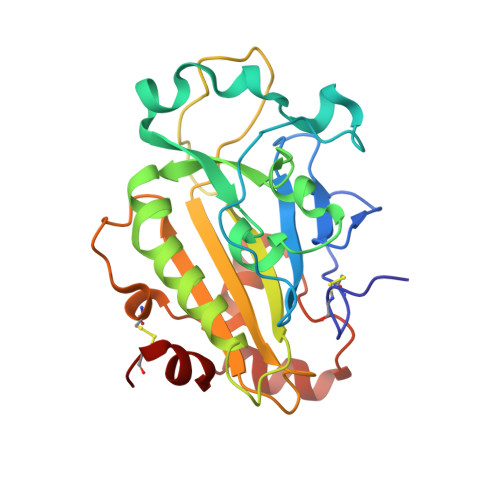Atomic Structure of the Serratia Marcescens Endonuclease at 1.1 A Resolution and the Enzyme Reaction Mechanism.
Shlyapnikov, S.V., Lunin, V.V., Perbandt, M., Polyakov, K.M., Lunin, V.Y., Levdikov, V.M., Betzel, C., Mikhailov, A.M.(2000) Acta Crystallogr D Biol Crystallogr 56: 567
- PubMed: 10771425
- DOI: https://doi.org/10.1107/s090744490000322x
- Primary Citation of Related Structures:
1G8T, 1QL0 - PubMed Abstract:
The three-dimensional crystal structure of Serratia marcescens endonuclease has been refined at 1.1 A resolution to an R factor of 12.9% and an R(free) of 15.6% with the use of anisotropic temperature factors. The model contains 3694 non-H atoms, 715 water molecules, four sulfate ions and two Mg(2+)-binding sites at the active sites of the homodimeric protein. It is shown that the magnesium ion linked to the active-site Asn119 of each monomer is surrounded by five water molecules and shows an octahedral coordination geometry. The temperature factors for the bound Mg(2+) ions in the A and B subunits are 7.08 and 4.60 A(2), respectively, and the average temperature factors for the surrounding water molecules are 12.13 and 10.3 A(2), respectively. In comparison with earlier structures, alternative side-chain conformations are defined for 51 residues of the dimer, including the essential active-site residue Arg57. A plausible mechanism of enzyme function is proposed based on the high-resolution S. marcescens nuclease structure, the functional characteristics of the natural and mutational forms of the enzyme and consideration of its structural analogy with homing endo-nuclease I-PpoI.
- Engelhardt Institute of Molecular Biology, Russian Academy of Sciences, Vavilov Str. 32, Moscow 117984, Russia.
Organizational Affiliation:

















